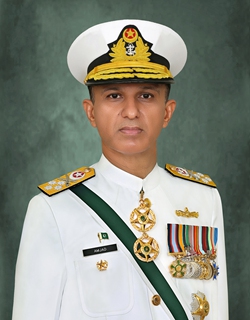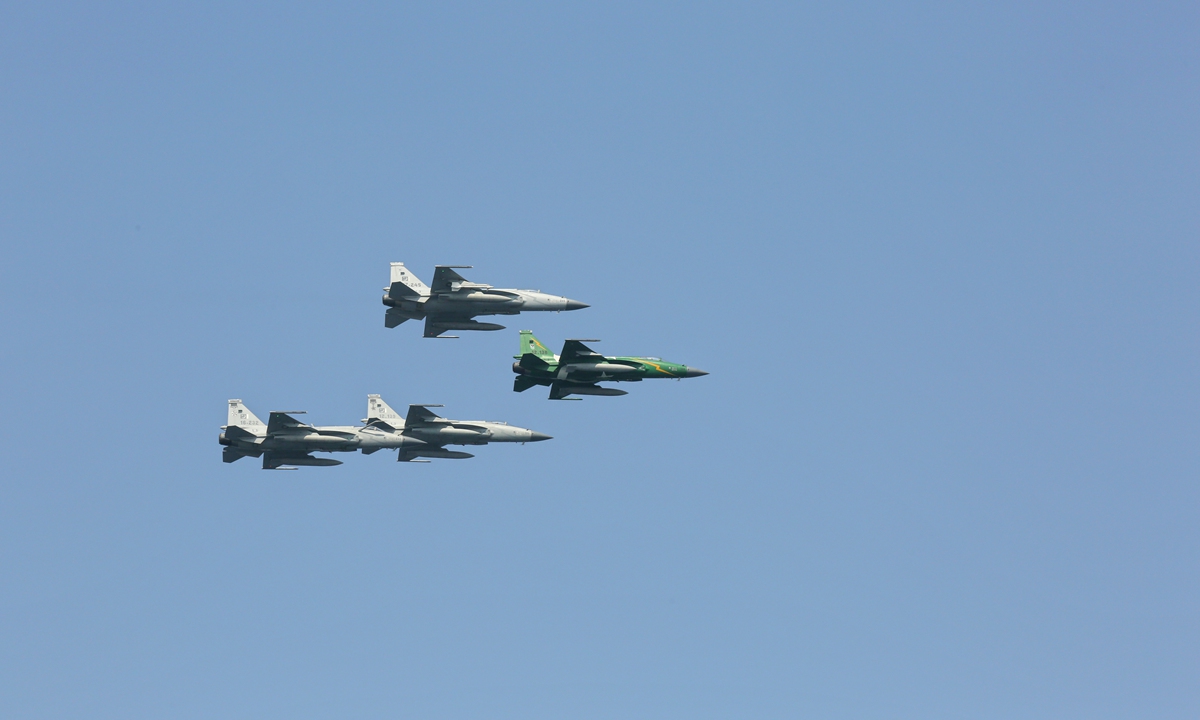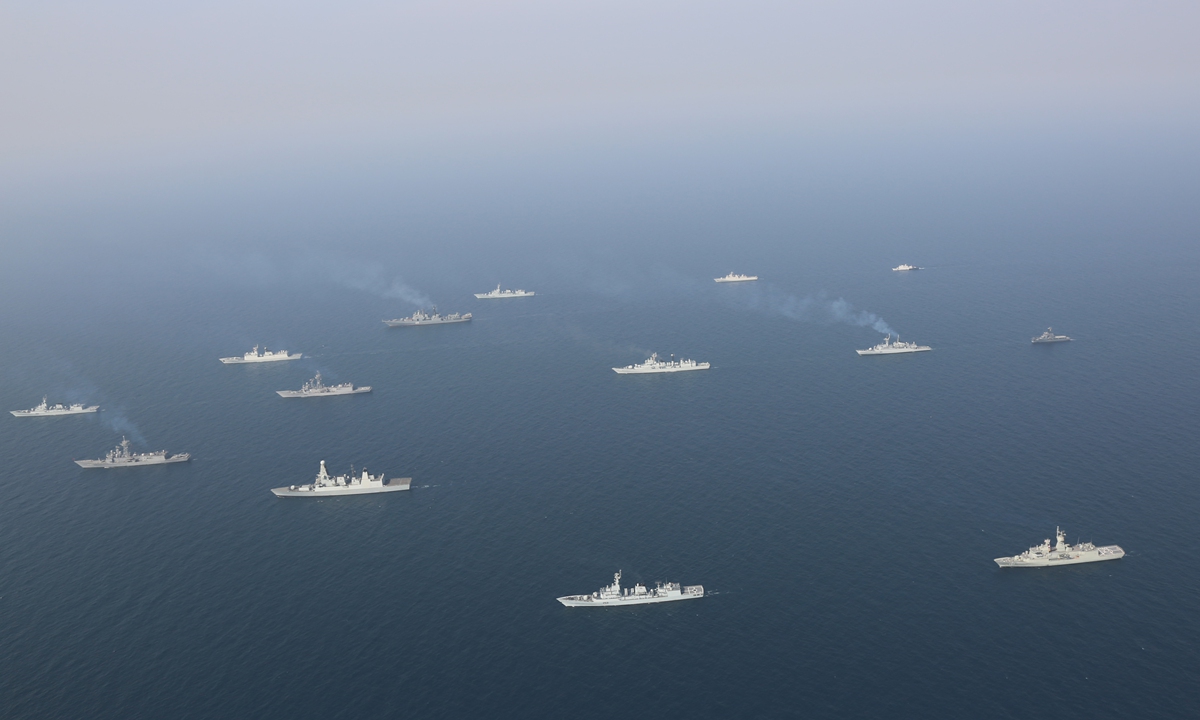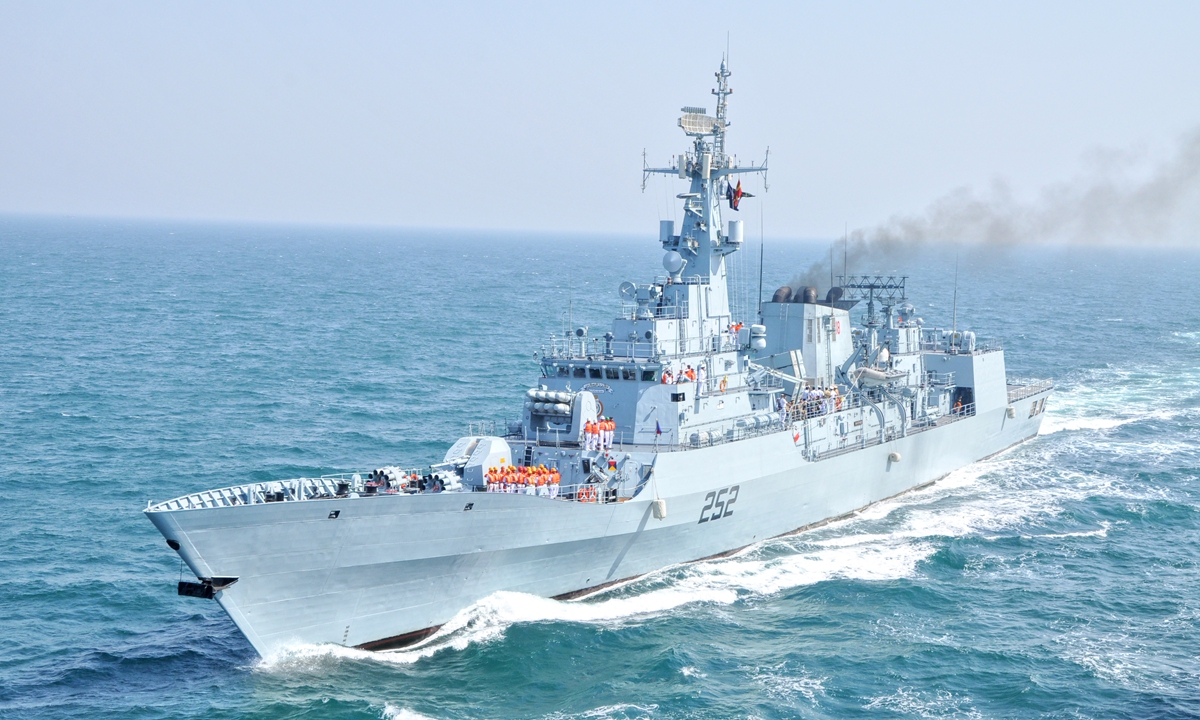CHINA /
DIPLOMACY
Pakistani, Chinese navies play important roles in maintaining maritime order of Indian Ocean: Exclusive with Pakistan Navy chief
By
Liu Xuanzun
and Guo YuandanPublished: Feb 04, 2021 04:23 PM
Editor's Note:
The Chinese People's Liberation Army (PLA) Navy is scheduled to participate in the Multinational Exercise AMAN-2021 hosted by Pakistan in February as dozens of navies around the world are about to gather in Karachi. Global Times reporters Liu Xuanzun and Guo Yuandan (GT) recently had an exclusive interview with Chief of the Naval Staff of the Pakistan Navy (PN) Admiral M Amjad Khan Niazi (Adm. Niazi), during which the Admiral shared his visions on topics including the PN's role in promoting regional maritime security, naval cooperation between the PN and PLA Navy, and the upcoming multinational exercise.
Prior to the interview, Admiral Niazi introduced the PN as a strong, agile and resolute navy that defends sea frontiers and protects maritime interests of the country. He said that in cognizance of Pakistan's geostrategic location in the Indian Ocean, at the doorstep of the Arabian Gulf, the PN has been playing an important role in promoting regional maritime security and good order at sea. "With the changing geostrategic realities in the region and operationalization of the China-Pakistan Economic Corridor (CPEC), the role and responsibilities of the PN are growing exponentially. The PN is steadily undertaking capability enhancement and capacity development to optimally deal with added responsibilities and evolving challenges."
Admiral M Amjad Khan Niazi, Chief of the Naval Staff of the Pakistan Navy Photo: Courtesy of the Pakistan Navy
GT: How do you visualize the changing maritime security environment in the Indian Ocean region and how does it affect Pakistan? In another sense, what are Pakistan's maritime imperatives and the significant threat being faced in the maritime domain?
Adm. Niazi: Pakistan is blessed with an important geostrategic location on the northern shores of the Indian Ocean and at the confluence of three regions namely the Middle East, Central Asia and South Asia. This gives us proximity to the Gulf of Oman which is an important global energy highway as nearly 33% of the world's oil shipments pass through this area. Pakistan's 90% trade is sea borne and most of our energy requirements are also met through the sea. Pakistan's maritime advantage stems from our over 1,000 kilometers long coastline and the potential offered by our exclusive economic zone of 240,000 square kilometers and continental shelf of 50,000 square kilometers, which is increasingly adding to the national economy.
In my assessment, the global geopolitical environment is undergoing an unprecedented transition, remaining highly volatile and is characterized by new alignments of interests and partnerships. Pakistan finds itself in the midst of a complex geopolitical and geo-economic competition prevailing in the region. Pakistan's maritime security is intertwined with the maritime environment in the Indian Ocean region which is rapidly transforming. In our immediate neighborhood, long drawn instability in Afghanistan simmers and continues to impinge upon regional security. On our eastern side, India, with an expansionist mindset, is destabilizing the region by actions that could imperil regional security.
On our Western flank, the US-Iran standoff has vacillated, posing risks to ships plying along the international Sea Lines of Communication (SLOCs). The ongoing conflicts in Yemen and Syria are also impacting regional maritime security. The warring groups' access to shore-based missiles and remotely operated vehicles is a serious threat to SLOCs transiting the Red Sea and the Gulf of Aden.
In the nontraditional domain and across the wider region, maritime terrorism, piracy, drugs trafficking and human smuggling are some of the major challenges being faced today. In short, the challenge to our regional maritime security is an ominous hybrid mix of traditional and nontraditional threats.
GT: Could you dilate on Pakistan's initiative of Regional Maritime Security Patrol and its objectives?
Adm. Niazi: Commensurate with the changing geostrategic realities, the PN launched the initiative of Regional Maritime Security Patrol (RMSP) in 2018 to fulfil its international obligations, enhance maritime security and protect its interests in the Indian Ocean region with strategic autonomy. RMSP is aimed at making seas safer for human use, augment maritime security and contribute to freedom of navigation in the Indian Ocean region.
RMSP seeks to create a stable maritime order through "integration rather than alienation." Another important objective of RMSP is to foster partnerships with other regional countries and enhance interoperability.
An F-22P frigate, marvel of Pakistan-China defense collaboration, sails the sea during Exercise AMAN-2019. Photo: Courtesy of the Pakistan Navy
GT: How do you see the PLA Navy's development and its role to security in the Indian Ocean region?
Adm. Niazi: The PLA Navy has shown phenomenal progress during the last two decades. Today, the PLA Navy has one of the largest standing fleet in the world and is operating state-of-the-art platforms. The PLA Navy has been sending its flotilla to the Gulf of Aden since 2009, which has contributed significantly toward maritime security in Indian Ocean region. The PLA Navy's participation in various multinational exercises, port visits and humanitarian assistance and disaster relief missions is reflective of its support for collaborative efforts to enhance stability in the Indian Ocean region. The PLA Navy's consistent participation in Multinational Exercise AMAN since 2007 and conducting of bilateral exercises have been conducive to the overall maritime security environment in the Indian Ocean region.
Emerging new challenges to maritime security, especially the asymmetric dimension of maritime terrorism, are daunting, which need a collaborative approach. The PN and PLA Navy with their longstanding and expanding cooperation can play an important role in maintaining good order at sea. The PLA Navy's presence in the Indian Ocean region is thus an important element in maintaining the regional balance of power and promoting maritime security.
GT: What are the recent major procurement and modernization programs of Pakistan, particularly from China? Could you share with us the latest development on the Type 054A/P Frigate Program, and the latest development on the submarine program with China?
Adm. Niazi: The PN development strategy is based on "progressive capability enhancement" to create a balanced, potent and combat-ready force to meet evolving threats. As part of this modernization, PN is replacing its existing ageing platforms with acquisitions from friendly countries along with transfer of technology for their in-country construction. In this regard, the PN and PLA Navy's historic and deep-rooted relations constitute a key element. The PN has been operating Chinese-origin platforms since the early 1970s. Cooperation between the PN and PLA Navy in various domains ranges from construction of naval platforms to bilateral exercises, training and high-level exchange visits. Naval collaboration between the two countries has been strengthened with the procurement of F-22P frigates, fast attack craft (missile), helicopters and state-of-the-art survey ship. The PN has also contracted construction of eight Hangor-class submarines, four Type 054A/P ships and medium-altitude long-endurance unmanned combat aerial vehicles from China.
With the changing threat dynamics and enhanced maritime security requirements, induction of modern and potent surface platforms like frigates, corvettes and offshore patrol vessels has assumed greater urgency. In this regard, Type 054A/P frigates are being acquired from China. These will be one of the most technologically advanced platforms of the PN Surface Fleet, equipped with modern surface, subsurface and anti-air weapons, sensors and combat management systems. These ships will boost potency of our fleet and significantly contribute in maintaining peace and security in the region.
The contract for acquisition of eight Hangor-class submarines was signed with China Shipbuilding & Offshore International Co Ltd. Of these, four submarines will be constructed in China while the other four will be built in Pakistan. These submarines, once inducted, would substantially add to the offensive capability of the PN Fleet.
Besides these, other major programs include enhancing our long-range anti-submarine warfare and anti-surface warfare capability through induction of long-range maritime patrol jets, unmanned combat aerial vehicles and modernizing our existing fleet with state-of-the-art weapons and surveillance systems.
We are also looking at acquisition of modern helicopters, corvettes and shallow-water attack submarines.
JF-17 fighter jets, symbols of Pakistan-China defense collaboration, fly over the sea during Exercise AMAN-2019. Photo: Courtesy of the Pakistan Navy
GT: PLA Southern Theater Command participated in the Exercise SEA GUARDIANS-2020 in Pakistan. Please give us an insight on its objectives and conduct.
Adm. Niazi: Exercise SEA GUARDIANS-2020 was conducted in the North Arabian Sea from January 4 to 14, 2020. This was the first instance that PN-PLA Navy bilateral exercise was conducted under the ambit of PLA Southern Theater Command. SEA GUARDIAN series of exercises is aimed at fostering interoperability and sharing professional experiences to deal with contemporary traditional and nontraditional threats in the Indian Ocean region. The Exercise included joint maneuvers, anti-surface, anti-air and anti-submarine drills. The Exercise provided a useful opportunity to strengthen bilateral naval cooperation and promote safe and secure maritime environment in the region.
GT: Chinese State Councilor and Defense Minister Wei Fenghe recently visited Pakistan. In which aspects will China and Pakistan navies cooperate in 2021?
Adm. Niazi: PN and PLA Navy enjoy long-standing, broad-ranging and strengthening bilateral relationship. Close collaboration between the two navies exists across multiple domains including acquisition of platforms, equipment, bilateral exercises, technical cooperation, navy-to-navy expert level staff talks, training collaboration, exchange visits and port calls. Both navies remain committed to expanding and consolidating this relationship for regional peace and good order at sea.
GT: There have been reports claiming that the PLA is mulling to build a naval base in Pakistan. What are your comments on these reports?
Adm. Niazi: The Belt and Road Initiative (BRI) is an economic integration initiative of China which will improve interconnectivity and usher massive growth across regions. The ongoing CPEC, a flagship project of the BRI, would contribute significantly toward economic prosperity for all stakeholders. Infrastructure development under the CPEC will create job opportunities and economic development for the people of Pakistan, particularly in Balochistan and along the Makran belt. The CPEC is a manifestation of strong and fortifying ties between China and Pakistan, that will play a key role in the economic uplift and betterment of the entire region.
Gwadar is a commercial port that will serve as the lynchpin of the CPEC project. As the port gets fully operational, like any other commercial port, it may also receive port calls by ships of different navies. Karachi Port, for example, receives ships of different navies quite often. Visit of a commercial port by naval ships does not alter the commercial nature of the project. Moreover, the PN is taking all possible measures to ensure protection of Gwadar Port and its seaward approaches through sustained presence in and around the adjoining waters off Gwadar.
GT: China now operates two aircraft carriers. Will Pakistan invite them to visit Pakistan?
Adm. Niazi: Pakistan maintains close and ever-growing ties with China which has been one of the most steadfast and reliable partners for peace in the region. Chinese Navy hosts a number of modern and technologically advanced platforms in their inventory. Operating with these modern and high-tech platforms affords us an opportunity to refine our tactics and procedures. The PN and PLA Navy hold regular bilateral (Exercise SEA GUARDIAN) and multilateral (Exercise AMAN) exercises. It is heartening to know that the PLA Navy now operates two aircraft carriers. The PN would like to conduct an exercise with these carriers whenever an opportunity arises. Moreover, the PLA Navy and PN ships regularly visit each other's ports. In the same stride, the PN would continue to welcome further visits by PLA Navy ships, including aircraft carriers.
Together for peace. Warships gather during Exercise AMAN-2019. Photo: Courtesy of the Pakistan Navy
GT: What initiatives are being taken by Pakistan in terms of defense diplomacy with neighboring countries and major naval forces?
Adm. Niazi: We are a peace-loving nation and strive to maintain peaceful and cordial relations with all our neighbors and regional countries. In line with this national policy, the PN has been playing its role by actively engaging with the navies of all littoral states in the Indian Ocean region and beyond.
The PN, through naval diplomacy, contributes to the nation's foreign policy objectives by showing Pakistan's flag in countries far and wide; through key leadership engagements; navy-to-navy expert level talks; overseas deployments; and participation in bilateral/multilateral exercises on a regular basis. In 2019-20, PN ships proceeded on deployment around Africa in line with the government's "Engage Africa Policy." A PN ship is currently on a humanitarian assistance and disaster relief and goodwill mission to extend support and deliver food aid to African countries hit by floods and droughts.
The PN also projects Pakistan's maritime perspective at international fora and is a member of the Indian Ocean Naval Symposium and an observer in the Western Pacific Naval Symposium.
GT: What is the vision behind Pakistan's initiative of organizing a unique kind of Multinational Exercise AMAN in the region? What is the importance and relevance of the exercises for other countries in the region and international partners?
Adm. Niazi: Pakistan as a responsible maritime state has consistently contributed to advancing peace and stability in the region. Pakistan's commitment to the principle of "peaceful coexistence" and desire for greater regional harmony and cooperation is reflected through Pakistan's Armed Forces participation in UN Peacekeeping Missions, as well as various bilateral and multilateral engagements. Taking the lead, the PN took an initiative of holding biennial Multinational Exercise AMAN in 2007, to demonstrate Pakistan's commitment to peace, reinforce regional maritime security and enhance interoperability between regional and extra regional navies. Since then, this Exercise has become a major multinational maritime event, which is evident from the growing number of participating countries.
AMAN in Urdu means "Peace," and the motto of the Exercise, "Together for Peace," clearly reflects the importance and united resolve of all participating countries for collaborative maritime security. The AMAN series of exercises are significant in fostering regional cooperation for maintaining good order at sea, improving interoperability and exhibiting a common resolve against crimes and illicit activities in the maritime domain.
All littoral states in the region and international stakeholders are today increasingly alive to the challenges afflicting the Indian Ocean region, such as maritime terrorism, piracy, drugs smuggling, arms trafficking besides natural calamities. The vastness of oceans and easy availability of newer technologies have made the maritime arena an attractive avenue for illegal activities. Therefore, a consensus is growing that the myriad maritime security challenges of the present era require collaborative approach at regional and international levels. This can be achieved by enhancing cooperation, pooling resources and establishing common practices to tackle these challenges by all the participating navies. Exercise AMAN is, therefore, Pakistan's humble but focused initiative in this direction.
It is encouraging to see that the participation in the AMAN series of exercises has been steadily growing. The increased participation reflects growing trust in the value of the exercise and the PN's credibility in bringing navies of the East and West under a common platform, for good of the global commons.
GT: It is rare that Russia and NATO member states including the US are participating in the same Exercise. What subjects will be included in AMAN-2021?
Adm. Niazi: The AMAN series of exercises were initiated on the basis of a common cause, "Together for Peace," which in my view, is the principal motivation for all the participating navies to come together in pursuit of a secure and stable maritime environment in the region. The Exercise will involve various activities including maneuvers, weapon firing drills, maritime interdiction ops, flying ops, search and rescue exercises and international fleet review. Participation by a number of navies is indicative of Pakistan's standing in the international community, its strong multilateral ties and desire amongst all the participating countries to join hands in advancing peace and stability in the region, for our collective good.
GT: Some 42 countries are participating in Exercise AMAN-2021. How will Pakistan manage the risks posed by the COVID-19 pandemic? Will face-to-face discussions including tabletop exercises be reduced? Will the Exercise achieve its originally intended goals despite COVID-19?
Adm. Niazi: The PN is well cognizant of the threat of the COVID-19 pandemic. Accordingly, harbor events have been tailored to ensure the safety of participants in accordance with government policies. Major events will be conducted in open air with scaled down audiences. Since COVID-19 is not going away anytime soon, I reckon, there is a need to adapt to the COVID-19 reality and learn to live in these changed circumstances. By adhering to COVID-19 standard operating procedures and necessary precautions, we plan to conduct Exercise AMAN-2021 activities since it offers us a unique opportunity to further our collaboration and achieve common goals in the face of a global health challenge.













